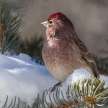
A seabird (Aethia pusilla) is the least auklet, and the smallest auk species. This is North America's most prolific seabird, with a population of about nine million birds, and one of the world's most prolific. They live on the islands of Alaska and Siberia, which sit on the edge of the ice sheet the winter. Their primary settlements are on the Aleutian Islands, St. Lawrence Island and Little Diomede Island. The tiniest member of the auk tribe is even larger than a sparrow. Abundant around the islands of the Bering Sea, where hundreds can be seen poised over the sea on rock stacks, chirping and chirring at a time. Sometimes winging low over the ocean in large flocks on very rapid beats of the tiny wings, or circling in the air over the breeding colonies. Least Auklets in their underparts pattern are oddly variable, and can be anywhere from white to spotted to dark-gray solids.
Both parents feed kids, take food to sleep in their neck pockets. Young adults, like most auks, rise faster than young people, leaving nest 25-33 days after hatch. Crosses starting at age 3. Male perches upright in courtship and makes chattering calls; female approaches in exaggerated extending and crouching postures, so that both birds engage in bill-touching and duet chatter. Pair-bond lasts a season, too. Nest: Rock piles, other locations in colonies located on the talus hills, with suitable small rock crevices for nesting sites. Not made of a nest, egg laid on flat rock, gravel or pebbles. Pair will reuse the nest site for many years.
They eat crustaceans, and other marine invertebrates. Summer diet include small species that exist in swarms in cold environments, mostly very small crustaceans known as calanoid copepods, some euphausiid shrimps, some amphipods, among others. Diet which at other seasons is not well known. Forages when swimming underwater. Underwater fast and agile but not probably capable of very deep diving. Incubation typically lasts approximately 30 days, from 25-39 days for both sexes. Both parents eat young, taking food to sleep in their neck pockets. Young grows quicker than young, like most auks, leaves the nest 25-33 days after hatch. Lesser auklets mainly feed on calanoid copepods, particularly those of the Neocalanus genus. They also consume the euphausiids, pteropods, and other zooplankton species. In stratified waters, where upwelling and thermoclines cause these prey species to clump closely together, they are searching for those. Unlike most auks, they chase divers, use their wings to provide propulsion and "hop" underwater.
They are voracious hunters who eat 86 per cent of their body weight every day. The smallest auklets are extremely aggressive, breeding in rocky crevices into groups of up to one million individuals. These colonies are mostly mixed, mating with other species of auklet, and vying with the least auklet. Despite this coexistence with other species providing the advantages of predator defence, the lesser auklets remain vulnerable to removal by larger crested auklets from their nesting sites. A single egg is laid in the crevice and incubated for one month, after which a semi-precocial black downy chick is hatched. The two parents share incubation, brooding, and feeding functions. Unlike other auks that feed cross-border fish in the mouth, copepods and other zooplankton are feeding the least auklet chicks from a sublingual pouch, much like other other auklets. The chicks will not need any further parental care because they have escaped, and will dive to hunt as soon as they leave the nest. Minor auklets are vulnerable to oil spills, and invasive animals. The arrival of Arctic foxes on many of the Aleutian Islands caused the animals to be wiped out on many of those islands and rats are now a problem on other islands. However, they are still still a very widespread species, and are not known to be vulnerable by the IUCN.
About the Creator
MB
I am a bird aficionado and really enjoy spotting them them on hikes. I greatly appreciate the variety of birds cross North America and the world. They are amazing and intelligent creatures, each so unique and with a wonderful life.






Comments
There are no comments for this story
Be the first to respond and start the conversation.